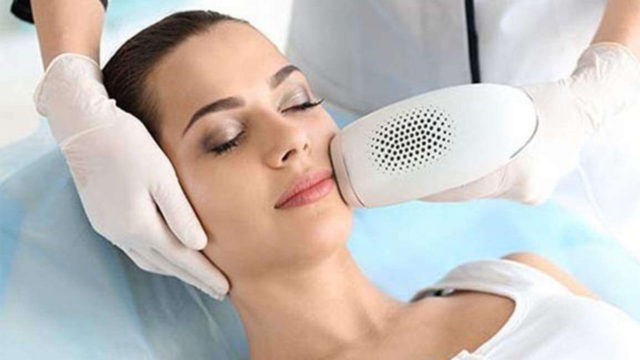Polycystic ovary syndrome (PCOS) is a hormonal condition affecting 10% of women. In this condition, insulin resistance or imbalance in pituitary hormones LH and FSH (more LH, less FSH) causes the ovarian follicles to not mature properly. Usually, in every monthly menstrual cycle, one ovarian follicle matures and then ovulates, leading to regular cycles (periods). So common is PCOS among women that the month of September is commemorated as PCOS Awareness Month.
In collaboration with The Channel 46, Dr Smriti Naswa Singh, Consultant Dermatologist & Cosmetic Dermatologist, Fortis Hospital, explains why PCOS may cause hirsutism or excessive facial hair and advises 5 ways to deal with it.
Why Is PCOS Giving You Excess Facial Hair (Hirsutism)
The follicles of PCOS patients do not mature, so they do not ovulate, leading to irregular cycles. Also, in PCOS, ovaries produce excess androgens (hormones). These androgens are generally produced more in men (by their testes and adrenal glands) and less in women (by ovaries and adrenal glands). The androgens affect the hormone receptors on the hair follicles of the chin (beard area), upper lip (moustache area), chest and abdomen (midriff) and in some cases, the upper back and upper arms. This hormone converts the soft, brown vellus hair into dark, long, thick, coarse, and sometimes curly terminal hair.
This hormone (androgens) converts the soft, brown vellus hair into dark, long, thick, coarse, and sometimes curly terminal hair.
Usually, men have terminal hair on their faces as a beard and moustache and on the chest, upper back, and arms. Women have hair only in the armpits and pubic region as part of the secondary sexual characters that get activated post-puberty and do not get hair in the areas mentioned above, which is common in men.
PCOS makes women grow terminal hair, which is called hirsutism.
PCOS makes women grow terminal hair, which is called hirsutism. The androgens also activate oil glands associated with these hair follicles, making PCOS patients prone to stubborn acne.
3 Ways To Combat Hirsutism
The treatment of hirsutism is three-pronged:
- Medical management of the underlying hormonal problem
- Treatment of excess hair
- Lifestyle modification
5 Ways To Deal With Hirsutism
1. Treating Hormonal Problems
In medical management, the endocrinologist or gynaecologist or dermatologist, or together as a multi-speciality approach, conduct blood tests on a patient for hormonal evaluations.
In medical management, the endocrinologist or gynaecologist or dermatologist, or together as a multi-speciality approach, conduct blood tests on a patient for hormonal evaluations. Once the report is studied, medications are prescribed accordingly. Some common medicines for this condition are birth control pills, while anti-androgens and drugs (usually anti-diabetic medicines) are for insulin sensitivity. These medicines help to correct the ongoing hormonal imbalance, which prevents the further conversion of vellus hair into terminal hair.
2. Treatment Of Excess Hair
Depending on the extent of hirsutism, women can choose to shave, epilate, depilate, pluck, wax, or thread their hair. In most situations, it is recommended that it is best to use an electric shaver than a manual shaver as those will cause fewer scratches and irritation.
Another treatment method is using a medicated cream that helps to control hair growth. However, as soon as the usage of the product is stopped, hair begins to grow again. These creams are not safe during pregnancy or breastfeeding. Therefore, a doctor must be consulted before you decide to use them.
Other possible procedures include:
3. Electrolysis
To treat hirsutism through electrolysis, a dermatologist will place a pin inside the hair follicle using an external machine, using an electric current to kill the root.
To treat hirsutism through electrolysis, a dermatologist will place a pin inside the hair follicle using an external machine, using an electric current to kill the root. Although home electrolysis machines are readily available, they are not as effective and do not show good results. As a result, it is better to consult a certified dermatologist.
4. Laser Hair Reduction
These laser machines throw light beams on the hair, which destroys the hair root by attacking the melanin in them.
There are various laser modalities like a diode, long-pulsed NdYAG, and alexandrite available with dermatologists to help control hirsutism. These laser machines throw light beams on the hair, which destroys the hair root by attacking the melanin in them. It is also found that lighter skin with darker hair responds best to this treatment.
Also, remember that the above treatment procedures require multiple sessions and may show a regrowth if the hormonal imbalance is not managed or if the imbalance recurs.
5. Lifestyle Modification
One of the best ways to treat PCOS, including the effects of hirsutism, is by making proper lifestyle changes, as this forms the crux of the treatment. Since lifestyle choices mainly cause PCOS, a part of metabolic syndrome, which includes diseases like obesity, diabetes, high blood pressure, high cholesterol levels, and endometrial (uterus) cancer, is also at increased risk in patients with PCOS. In other lifestyle modifications are extremely important for patients who have been diagnosed with PCOS, so that they can prevent these diseases from occurring in the future.
Further, PCOS patients must target a healthy body weight with a Body Mass Index (BMI) targeting less than 23, especially Indian women. Following a high-fibre diet and regular exercise makes it easier to balance the hormones in the body and prevent the ill effects of PCOS. Additionally, fasting for 16-20 hours can help insulin sensitivity. However, any form of fasting must be undertaken only after a consultation with a dietitian or nutritionist, so that nutritional deficiencies do not make weight loss harmful or detrimental to a person.
In conclusion, multiple lifestyle reasons can cause hormonal imbalances (also called endocrine disruptors) like plastic in food and water (storing even BPA-free plastic, cooking in non-stick), wearing polyester, certain ingredients like phthalates and parabens in cosmetic products, pesticides in food, hormones in animal foods and dairy. These lifestyle habits need to reform, and a focus needs to be shifted to clean eating and lifestyle patterns, which will be adequate to treat hirsutism and reverse polycystic ovaries and reduce the chances of it recurring.
Open up like never before and participate in conversations about beauty, entrepreneurship, mental health, menstrual & sexual health, and more. Desi women, join our community NOW!



